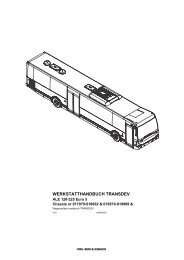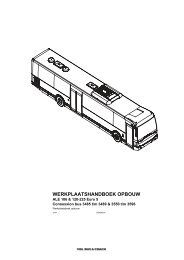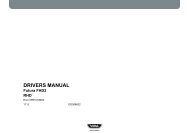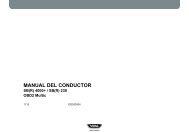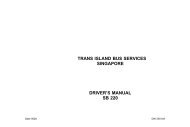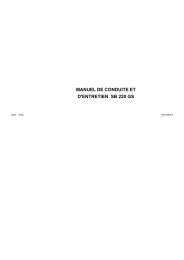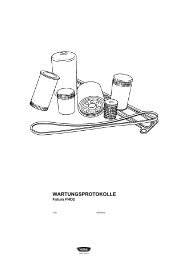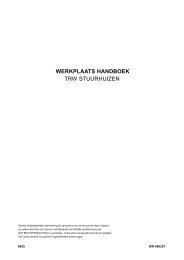DRIVER'S MANUAL SB220GS - Training Registration System
DRIVER'S MANUAL SB220GS - Training Registration System
DRIVER'S MANUAL SB220GS - Training Registration System
You also want an ePaper? Increase the reach of your titles
YUMPU automatically turns print PDFs into web optimized ePapers that Google loves.
Specification of coolants<br />
Coolant is a noxious fluid.<br />
Protect skin and eyes.<br />
Coolant is harmful for the environment; after use,<br />
it should be processed as industrial waste.<br />
The cooling system should preferably be filled with a ready-mixed<br />
coolant containing antifreeze and corrosion-inhibiting additives.<br />
When tap water is used, an ethylene-glycol based antifreeze must<br />
always be added as well as corrosion-inhibiting additives if there is<br />
a possibility of the ambient temperature falling below +5°C.<br />
- For protection down to - 18°C, a solution containing 33%<br />
antifreeze can be used.<br />
- For protection down to - 37°C, a solution containing 50%<br />
antifreeze can be used.<br />
Both ANTIFREEZE and ANTI-CORROSION coolants must<br />
satisfy the following specifications:<br />
ethylene-glycerol: ASTM D-3306, BS 6580 and SAE-J-1034;<br />
propylene-glycerol: ASTM D-5216 and BS 6580.<br />
Ethylene-glycerol and propylene-glycerol must never be mixed<br />
because the agents cannot tolerate each other. It is also better not<br />
to mix one type of glycol coming from different manufacturers.<br />
In the summer, coolant containing antifreeze can remain in the<br />
cooling system.<br />
The antifreeze concentration, and the protection taken, for example,<br />
against corrosion, should then also be kept topped up.<br />
In climates where temperatures never fall below + 5°C, it is sufficient<br />
to add a corrosion-inhibiting agent to the coolant according to ASTM<br />
D-3306.<br />
Follow the manufacturer’s instructions when using coolants.<br />
Coolant quality requirements:<br />
- pH 5.5-9.0<br />
- total solid matter ≤ 340 ppm<br />
- Hardness ≤ 170 ppm (calcium and/or<br />
magnesium carbonate).<br />
- Chloride ≤ 40 ppm (sodium chloride)<br />
- Sulphate ≤ 100 ppm (magnesium<br />
and/or sodiumsulphate)<br />
In regard to the use of additives, the cooling system should be<br />
flushed out and filled with the new coolant every two years.<br />
The information and data given above are based on normal<br />
operating conditions. As the specified substances are marketed<br />
under various brand names, consult your lubricant supplier for the<br />
correct interpretation of these specifications.<br />
TECHNICAL INFORMATION<br />
81



